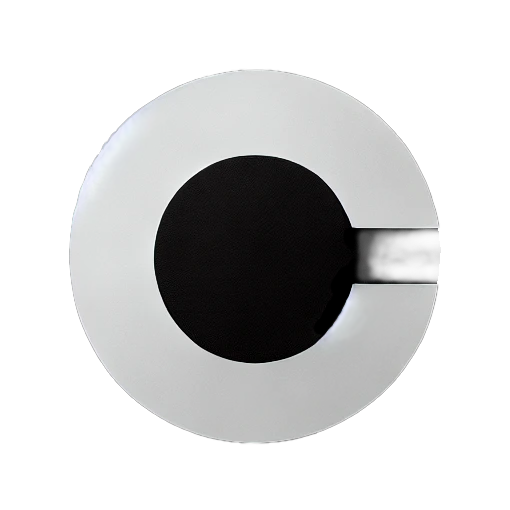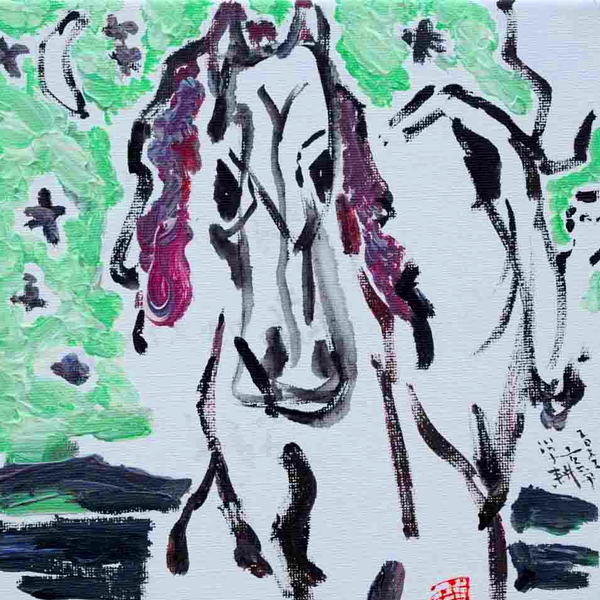Encountering Gu Xuegeng’s series A Journey Through Mountains and Rivers (《千山万水》) was both inspiring and profoundly enlightening.
.jpg)
This is a collection of modern oil paintings themed around horses. These horses do not inhabit real grasslands, nor do they attempt to replicate traditional pastoral scenes. Instead, they gallop across waves of color and ridges of texture, charging through the canvas like storms of pure intention. Sometimes silhouettes, sometimes flames, or just gestures of speed and direction, these horses are at once grounded in reality and transcendent, becoming symbols of time, rhythms of life, and embodiments of thought—akin to Gerhard Richter’s oscillation between abstraction and realism.
The title “A Journey Through Mountains and Rivers” evokes a classical Chinese phrase that connotes arduous travel and, metaphorically, inner journeys. The artist’s intention is not to depict physical hardship, but to awaken the viewer’s resonance with this psychological trek—from external reality to the depths of the soul.
.jpg)
The entire series springs from a profound spiritual reservoir. In composition, form, brushwork, and color, the paintings exhibit freedom and fluidity. With bold contrasts and dynamic energy, Gu detaches the horse from its traditional cultural weight and projects it into a broader, more abstract, and spiritually modern context. Unlike conventional horse paintings, these works lean toward abstraction, spontaneity, and the immediacy of the moment. The horse is no longer a modeled object of anatomy or light, but a field of deconstructed motion, abstract energy, and psychic directionality.
.jpg)
In many paintings, the horse is outlined only by broken lines and fragments of color. The brushwork is brisk, improvisational, yet carries immense kinetic force. This marks a leap from representation to inner vision, echoing modernist pursuits of psychological truth over outward likeness.
If form is the structural backbone of the series, then color is its emotional bloodstream. The artist boldly employs saturated hues—orange-reds, indigos, violets, luminous greens—set against one another in irregular collisions to build rhythm. This approach diverges from the Chinese tradition of spatial emptiness and monochrome subtlety, aligning more closely with Western modernism. There are echoes of Matisse, de Kooning, and Zao Wou-Ki, whose chromatic intensity shaped emotional space. Here, foreground and background dissolve—every inch of canvas is saturated with pigment and affect.
.jpg)
-675x1024.jpg)
Far from being decorative, this chromatic strategy forms an emotional waveform. The viewer is not just observing horses but listening to a soul in motion—colors control tempo, create climaxes, and guide waves of feeling.
-698x1024.jpg)
In modern art, physicality and speed are often central to breaking tradition. Pollock’s “action painting” famously synchronized motion with psyche. Similarly, Gu’s brushwork may not veer into pure abstraction, but it expresses comparable immediacy and passion. There is no hesitation, no conservatism—only the youthful abandon of energy in motion. That sense of freedom becomes part of the painting’s essence: art no longer as the accumulation of time, but a reverse charge against it.
In traditional Chinese culture, the horse symbolizes power, expedition, masculinity, and loyalty. In the West, since Romanticism, it has become a metaphor for freedom, individuality, and wildness. Gu’s horses serve neither traditional narrative nor utilitarian roles—they are stripped of fixed meaning and re-endowed with existential presence. They are not tools, but beings.
Particularly striking are the works that capture moments of “still movement”: a horse gallops without destination; the painting leaps without noise. This restrained energy demonstrates the artist’s dual command of control and release—liberating the horse from figuration while retaining its kinetic truth; cultivating emotional intensity without slipping into visual chaos.
These canvases are like secret winds of the soul, traversing the ridges of time, breaking through the boundaries of image and language. The horse ceases to be merely a horse, and becomes speed, emotion, awareness, and presence. Ultimately, what the viewer encounters is not just the horse or the color—but the artist’s heartbeat, a living pulse launched into a spiritual passage through mountains and rivers.
The series also reaffirms Gu Xuegeng’s deeply modern visual philosophy. He no longer uses the horse to tell stories, but to generate existential tension—a sprinting horse is an energy flare; overlapping horses create spiritual fields. The horse is not just the subject, but the generative grammar of the whole painting. This reveals not only the artist’s disciplined practice but his metaphysical faith. The Daoist ideal of “image as spirit, form as path” finds new life in this contemporary visual structure.
.jpg)
.jpg)
.jpg)
Therefore, A Journey Through Mountains and Rivers is more than a horse series—it is a redefinition of artistic language and cultural stance. It revitalizes tradition within the pace of modern rhythm while preserving emotional sincerity and spiritual depth. These works are not merely technical evolutions—they demonstrate that art’s true nature lies not in representing the world, but in regenerating the soul. One cannot help but recall Picasso’s late bullfighting pieces or Huang Zhou’s masterful, playful donkeys.
What moved me most was the series’ undeniable youthfulness: the freshness of thought, the nimble compositions, the fearless brushstrokes and exuberant colors. It is difficult to believe such an expansive body of work came from a septuagenarian. But more than that, it reveals an artist who continues to break through himself, to pursue the essence of artistic truth. Gu’s work transcends age with an inner freedom that reclaims a new visual language.
Reflecting on the current art scene makes this youthful spirit all the more striking. While many senior artists are still exploring, evolving, and generating vivid, liberated works, some younger artists have already retreated into stylistic rigidity or market-driven mannerism. In contrast, A Journey Through Mountains and Rivers stands as a compelling model of contemporary image-making—and a reminder that authentic artistic power always arises from deep within the human journey.
This, in the end, is the most beautiful echo of youth that can emerge from the long and rugged trek of art itself.
.jpg)
.jpg)
-806x1024.jpg)
-756x1024.jpg)
-800x1024.jpg)
.jpg)
.jpg)
.jpg)
.jpg)
-740x1024.jpg)
-741x1024.jpg)
-731x1024.jpg)
-735x1024.jpg)
.jpg)
-707x1024.jpg)
-711x1024.jpg)
其它作品
No post found!

